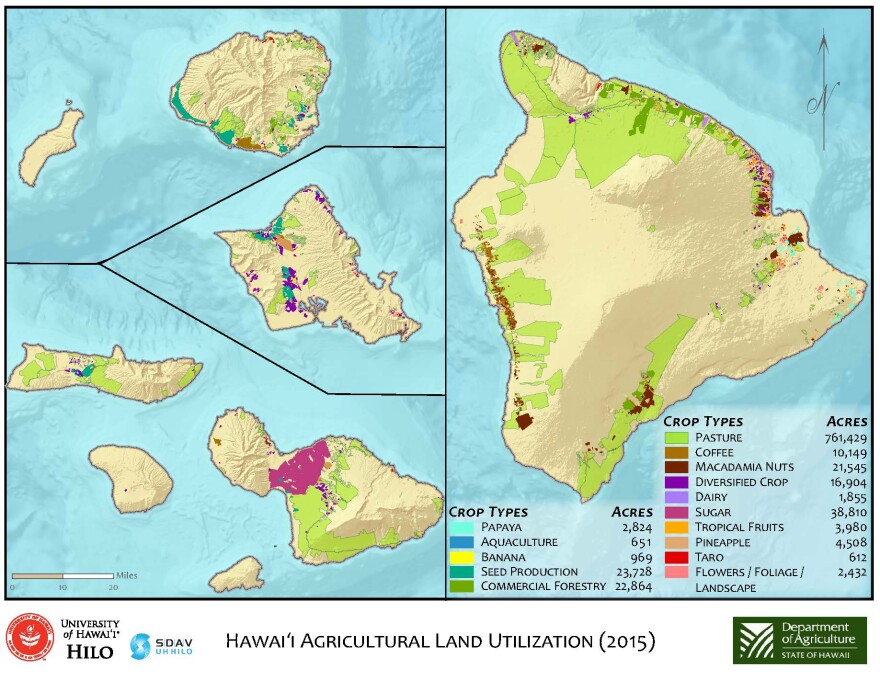Macadamia nuts are one of Hawaii’s most valuable agricultural products. This year’s harvest is estimated at more than 42 million dollars, a 22 percent decline from the previous year.
That’s still enough to make macadamia nuts Hawaii’s third most valuable crop, after coffee and seed corn. The vast majority of mac nut cultivation in Hawaii happens on the Big Island.
Local farmers brought more than 35 million pounds of macadamia nuts to market during the 2018-2019 harvest, down from 50,000 pounds the previous cycle. The U.S. Department of Agriculture counts a season as being from July 1st to June 30th of the following year.
The problem with this year’s harvest, as it has been for farmers across the country, was too much rain. Dan Springer, President of the Hawaii Macadamia Nut Association, told HPR that excessive rain starting in the summer of 2018 is the most likely cause of the decrease in macadamia nut yields.
“It gets too wet, for too long, the flowers start to rot on the trees, therefore the nuts never set, therefore the crop is down from what it had been in the past,” Springer said.
In 2018 the rain gauge at the Hilo International Airport measured its third wettest year on record, according to the National Weather Service. The deluge was largely contained to the windward side of the island. Springer said that production was about average at his macadamia nut orchard near South Point.
There was good news mac nut growers. The net farm price for a pound of nuts is at an all-time high, just shy of $1.20 per pound according to the USDA. Springer said that is helping small farms ride out a lackluster harvest, but may not be enough to fully cushion large operations with higher labor costs.

The market price of macadamia nuts has been steadily rising since 2006, when it bottomed out at 67 cents per pound. Springer said farmers have been seeing a steady increase in demand for their product, but there are supply side reasons for the high price as well.
Alyssa Cho, an agriculture researcher at the University of Hawaii at Manoa, said it can take the better part of a decade to get new macadamia nut trees planted and mature enough to produce.
“It takes about 2 years from seed to a treed that they can plant in the ground. And then it will take another couple years, usually 4-5 before they start producing,” Cho said.
Although historically high prices are helping insulate farmers from one off year, there is another problem that high prices will not be able to check. An invasive insect from Australia known as the Macadamia Felted Coccid has been found in all of Hawaii Island’s macadamia growing regions according to Cho.
As she puts it, “there is no silver bullet.” Mitigation measures for the Felted Coccid currently consist of pruning trees to encourage local predators to eat the coccid and the use of chemicals.
The insect invader differs from its caffeinated counterpart, the Coffee Berry Borer beetle in that it does not impact the quality of a macadamia nut harvest. The coccid leaches water and nutrients out of mac nut trees, slowly diminishing their output over time.
But there is hope, according to Cho. Researchers and farmers are seeking regulatory approval to introduce some natural predators of the Macadamia Felted Coccid to Hawaii from its native Australia. Parasitoid insects, which lethally lay their eggs in hosts like the Felted Coccid, are one option.
Even using natural solutions, the costs of controlling invasive pests are high. That’s true across the spectrum of agriculture, which Cho says is always under threat from some new invader or blight.
“There’s always a threat to all of agriculture. Any new pest or disease or change in availability of product could threaten industries.”
Correction: This story originally listed the harvest as being 35,000 pounds of macadamia nuts. It was actually 35 million pounds. USDA stats are done by the thousand, so the 35,000 published indicates a harvest of 35 million pounds.





